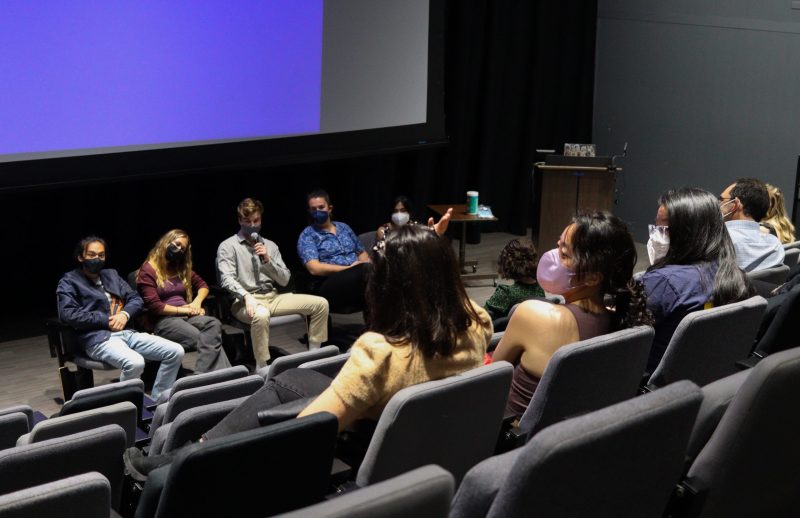“There was a ‘Wonder Boys’ style dent in Marie’s car from our director of photography sitting on it. That’ll be one of the legacies of the film,” joked Ben Schwartz ’22 during Golden Spike Studio’s (GSS) Valentine’s Day themed event.
As Stanford’s only student production company, GSS is run by undergraduates and held its debut screening in October. The company hosted their second screening on Sunday, featuring two student films: Marie Bland’s ’22 mumblecore short “To & From” and Ben Schwartz’s ’22 deadpan comedy “Jenga Night.” The films made the audience tear up and laugh aloud.
“To & From” tracks a pair of exes as they drive to their college graduation party and back. Bland was interested in cars as an underutilized space in film; they are enclosed, liminal spaces where the rest of the world is blocked out. The filmmaker liked how the confined space of a car moves the onus of plot progression heavily onto dialogue.
“I really like writing dialogue and fast bits of arguments, so my projects end up being stories between two characters,” Bland said.
In the short, Bland’s knack for dialogue is evinced by the naturalist back-and-forths between the protagonists, played by Kathryn Dragone ’22 and Valerie Trapp ’24. Bland also plays with euphemistic conversation — in one scene, the two girls struggle to talk about their relationship, so they deflect and talk about someone else’s. Realist intimacy, to the point of feeling invasive, defines the tone. In one scene, we watch Dragone holding Trapps’ face to do her makeup. I could sense the audience holding its breath during the characters’ arguments.
“’Jenga Night’ is about … two friends who play a game of Jenga,” quipped Schwartz when introducing his film to the audience. The film is absurdist and hilarious, with solemn exchanges of clipped inquiry. When one character probes the “elephant in the room,” the other asks, “What room?,” pointedly glancing around the obviously roomless construction site. The audience erupted into giggles. The deadpan tone of the film peaks in the final scene when the protagonists composedly watch their house burn down.
Wes Anderson’s influence is visible in Schwartz’s style: the way the characters enter the shots, the single-file walking sequences, the dignified, straight-faced dialogue and the center framing. “The characters are very understated in their dialogue,” said Schwartz. “The biggest device I was going for was understatement.”
Sofia Monroy ’22 and Lore Vasquez Olivera ’22, co-presidents of GSS, both emphasized the club’s devotion to the film community. They started the group together their sophomore year with the goal of fostering a community of filmmakers.
“Even if they haven’t been involved with filmmaking, we encourage people to just come and hang out on set,” Monroy said. According to Olivera, “To & From” marked the first full-crewed GSS production on campus.
Filmmaking is no easy feat, as the shorts’ contributors attested. GSS’s marketing director and editor for “To & From,” Grace McGinley ’22, described the difficulties of editing scenes with Bland’s improvisational directing style.
“Since each take was pretty improvised, stringing together the segments during editing was hard, a sort of puzzle piece process,” McGinley said. For example, since they had 12 shots of the short’s kissing scene and the build to the kiss was improvised each time, it was tricky editing the clips together to create believable escalation.
Bland originally wrote “To & From” as a play for a course taught by theater and performance studies artist-in-residence Amy Freed. However, Bland quickly realized that her script was better suited for film due its car setting, and adapted accordingly.
But filming in a car posed unique challenges. Schwartz, who was the gaffer, or chief electrician, for “To & From,” installed tubes with circulating lights around the car so they could mimic the effect of movement despite being still. Other challenges included navigating the physical barriers between the director and the actors due to the car’s walls, getting filming equipment in the car and the positioning of director of photography Georgia Sasso’s ‘25 throughout filming.
Schwartz also overcame obstacles while working on his own film, “Jenga Night.” The short was made over the pandemic in Schwartz’s hometown of Sacramento, California. He recruited friends as actors and used an under-construction housing development as the setting.
“The first night we were filming, a woman walking her dog asked us if we had permission to be there. When we said no, she called the authorities on us so we had to leave and return the next night,” Schwartz said.
Despite these issues, the two movies thoroughly charmed the audience. “It is a monumental task to make even a short film. The number of people from different artistic disciplines, the time, the logistics — they did a great job,” said senior lecturer and GSS faculty advisor Adam Tobin.
It was striking how the two films differed so greatly despite their shared framing: a conversation between two people. “To & From” melded personalities in earnest moments of intimacy and closure. The tension was entirely character driven, and the visceral aftermath of the protagonists’ relationship was emotionally accessible. Meanwhile, “Jenga Night” caused ripples of laughter with its staccato, quibbling conversation and borrowed tension from the riveting game of Jenga. The juxtaposition was immensely enjoyable. Moreover, it was obvious from the productive post-screening conversation and engaged audience members that GSS is truly succeeding at creating a film community at Stanford.
Editor’s Note: This article is a review and contains subjective opinions, thoughts and critiques.
